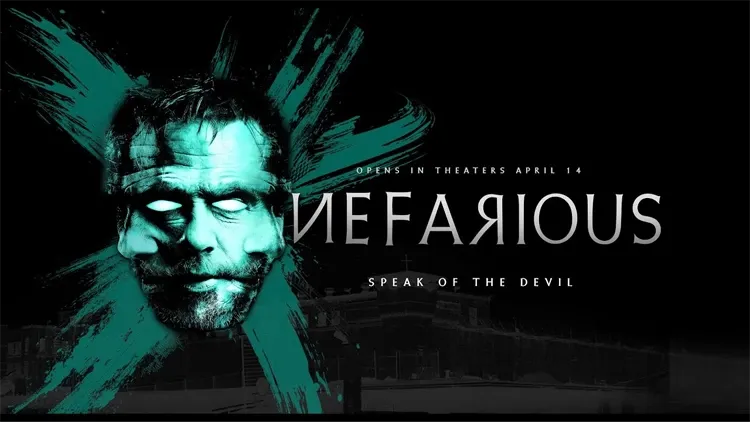***Warning, there are some very surface-level spoilers in this article***
After 11 years on death row, serial killer Edward Wayne Brady is *FINALLY* scheduled to be executed by electric chair. The only thing still left to do before he faces justice is for a psychiatrist to confirm that he is mentally capable of facing the penalty for his crimes.
This is where Dr. James Martin enters the story. He is the cocky, self-important psychiatrist who begrudgingly has been ordered by the court to determine the sanity of Brady.
We first meet Brady sitting in a chair, chained to a table, with a bit more hubris than would be expected from a man who is scheduled to be executed later that evening.
The movie gets to its point early in the first dialogue between Brady and Martin when the two begin a discussion about Martin’s ability to spare Brady the fate that is looming:
Brady: Death doesn’t scare me, James.
Martin: Why is that?
Brady: Because I can’t die. You see James, I’m a demon, Edward is merely my host body I inhabit.
From here the interaction between these two characters makes up more than 80% of the screen time in this movie. With the exception of the prison warden and the prison chaplain, no one else plays a substantial role in the telling of this story.
Nefarious, the name of the demon that currently possesses Brady, takes Martin on a wild ride of psychological and spiritual manipulation - informing Martin that by the time their conversation is over Martin would be guilty of killing three people.
Over the course of the next hour and a half the two wrestle back and forth with one another, neither ever actually being the “good guy” and both at odds with one another regarding primal topics of good vs evil.
The most gripping part of this movie is the way in which Sean Patrick Flanery, who plays the possessed man, masterfully transitions back and forth between Edward, who is tortured by the devil that controls him and is always full of fear, anxiety, and doubt, and Nefarious, the devil who spits out his rhetoric with scoffing pomp and arrogance.

One of the most powerful scenes comes early on when Martin calls in the prison chaplain as a means of challenging Nefarious: immediately upon the entry of the chaplain the demon recoils back and begins to curse and attack the chaplain.
But the demon soon discovers that the chaplain is not the sort of a Christian that any demon would be afraid of, but instead is a sophisticated sort of a Christian, far too refined to believe in such things as the supernatural. The message hits home here, as the movie metes out a solid condemnation of the sort of materialism that has taken a foothold in American Christianity.
Another interesting theme in this movie is that, of all the characters, the only character that isn’t a materialist is the demon. This unique plotline creates an opportunity for a surprising angle on age-old discussions, as the demon provides the most cogent defense of the supernatural, while at the same time extolling the victory of the demonic realm for so effectively getting humans to embrace materialism.
Another thought-provoking aspect of the movie is how it takes an unusual journey through the battle between good and evil while somehow having no characters who really qualify as good guys.
The movie soundly correlates abortion, the slaughter of innocent children in our day, with the ancient pagan practice of child sacrifice. Better yet, it does this by presenting a vivid picture of how the demonic realm responds when babies are murdered.
Additionally, it addresses the topics of euthanasia, transgenderism, and the power of progressive propaganda. All of these things are presented as useful tools of the demonic realm, employed in the task of deceiving and destroying humanity.
Perhaps the greatest attribute of this story is that it makes no effort to rescue itself from the story it is trying to tell. Though there are some redemptive themes mentioned throughout the movie, this is not a redemption story.
Instead, this movie tells the gritty, theologically ordered, non Hollywood-dramatized (though very intense) story of what the demonic realm is attempting to accomplish in our culture right now. And it manages to do all of this without being preachy because it’s the demons and not the angels drawing all of the lines between good and evil.
Really, my only criticism of this movie is the Catholic theology that comes out as the story unfolds. In particular, the movie has a passing reference to a Catholic theology of baptism, and then passively comes back to that idea again when it addresses the issue of abortion. Honestly, while I disagree with these ideas, a person would have to be paying very close attention to even catch that they are in the movie.
Some have complained that there were no clear presentations of the Gospel at any point in the movie. I disagree with this criticism both on its pretense and on its conclusion.
First, not every Christian movie has to have a clear step-by-step stroll through the points of the Romans Road to count as a Christian movie. This movie presents a broadly solid presentation of demonic possession, and it also shines a big bright light on the manifest evidence that the kingdom of darkness is rapidly advancing in our culture.
This is Christian storytelling at its best!
Second, I also disagree with the conclusion that the Gospel was not in this movie. At one point in the movie Nefarious chronicles how the crucifixion of “The Carpenter” was a great failure of the demonic agenda, as “The Enemy” used this great event to defeat them.
Nefarious also repeatedly speaks of “The Carpenter” as the great enemy of the Demonic hosts, and the movie shows in many ways how if any Christian at any time had come in the name of Jesus, and brought the Gospel to this man, he could have been redeemed.
Sadly, none did. That’s a part of the story the movie is trying to tell.
Gratefully, even if you don’t think there is enough Gospel in the movie, the good news is the conclusion brings a huge opportunity for you to share the Gospel with all who see it.
As the movie comes crashing to a dramatic conclusion, one final theme is “You have been weighed in the balance and found wanting.” The way this idea is presented will help the ears of moviegoers to be wide open to the message of forgiveness that can be found only in the Lord Jesus Christ!
I think this movie is an excellent movie, and I would strongly encourage you to go see it!
Also, this movie is very intense and has some moments that are very hard to watch. I would strongly encourage you not to bring children. This movie is not for little eyes.
Finally, I WOULD encourage you to bring a stack of bible tracts with you and pass them out to people as they leave the theater. Perhaps God by His mercy will save some through the message of this movie.
May it be so in Jesus’ mighty Name.



